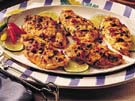|
|
Cuisine Glossary
| You have reached our International Cuisines and information on all aspects of a countries cuisine.
We will try to explain the culture, significant influences, climate, and other factors that have come together to create a distinct style. For example: Spanish, Mexican or Japanese. |
Jamaican Cuisine
 |
Jamaican cuisine is healthy because it is made with many unprocessed foods, uses smaller portions of meats, has a high content of fish, beans, and vegetables, and, most of all, because it is an eclectic mix of the best that African, European, Indian, and Chinese cuisines have to offer. Moreover, Jamaicans have always been aware of the relationship between food and health. Perhaps Jamaican cuisine is healthy due to luck or happenstance. How else can anyone explain why some of the most highly rated medicinal herbs, e.g., ginger, garlic, all spice and hot peppers just happen to be the basic seasonings used in Jamaican cuisine.
Some Jamaican dishes are made from familiar ingredients, but prepared in different ways from what you are probably familiar with at home, others are made from ingredients you more than likely did not even know existed. Also, because of the diets of the local livestock, you will notice a difference in the flavors of meats such as pork and chicken. Jamaican chickens in particular have a wonderful flavor. The national dish of Jamaica is not the renowned Jerk Pork or Jerk Chicken, but Ackee and Salt Fish. Ackee is the fruit of an African tree brought to Jamaica by the infamous Captain Blygh as food for the slaves. The appearance of the dish is somewhat like scrambled eggs, but there the resemblance ends. Although ackee itself is fairly bland in taste, the combination of the salt cod and spices give it a flavorful and distinctive taste. Some people find the taste of the salt cod too strong for their liking, so ask your cook to be moderate with her use of the cod. Bacon or salt pork may also be added as flavoring for the ackee. A word of caution; unripe ackee can be poisonous. It is very easy to tell if the ackee is ripe, and ready for eating. When ripe, the bright red pod opens to expose the yellow fleshy edible section of the ackee. Your experienced cook will have no trouble selecting ackees that are ready to be eaten, and any she will buy in the market will be edible. Jamaican breakfasts tend to be more substantial and varied than the typical North American fare of cereals or eggs. One of our favorites is Bully Beef and Johnny Cakes. Bully Beef is actually a spicily seasoned version of corned beef hash: the name comes from a brand of canned corned beef that was popular in Jamaica, but you can use your favorite brand instead. Recipes for Johnny Cakes vary widely according to the tastes of the cook; the one included here is a typical representation of these hearty biscuits. Other typical breakfast foods include Calaloo, a leafy green that has the appearance of spinach, but with its own distinct flavor. Calaloo is usually served sautéed with onions, peppers, salted cod and spices, but may also be used a filling for omelets. Standard accompaniment for sautéed calaloo is boiled green bananas. Green bananas are simply regular bananas that are eaten before they are ripe. These need to be cooked, and may be used as a replacement for potatoes or other starches. For the seafood lover in you, try the Escovitch Fish, in this dish, the fish is fried then marinated in a spicy vinegar sauce, and may be served either hot or cold. Another seafood favorite is Curried Lobster, spicy and flavorful, with a strong East Indian influence. Jamaicans eat a lot of chicken, and have many wonderful ways to serve this mainstay. Sampling of the Curried Baked Chicken is a must. The preparation is not that alien to how we would do it at home, however, the subtle differences in spices result in a unique taste experience. The Fricassee Chicken is truly one of the great Jamaican contributions to the art of chicken preparation. The chicken is browned then braised in a flavorful liquid which is then used to make a gravy. You may also want to try the Curried Chicken, one of the many Jamaican dishes of East Indian origin. Jamaican style Pork Chops is another dish that is a variation on familiar North American fare. These pork chops are seasoned, browned and then braised. An excellent accompaniment for this dish is the famous Jamaican Rice and Peas. Another rendition of Jamaican pork chops is the recipe we got from Hyacinth, the cook at Almond Tree Villa in Mammee Bay. The Honey-Ginger Pork Chops demonstrate the variety in Jamaican cuisine, and have their roots in Chinese cooking, which has a surprising influence on Jamaican cuisine. Those of you with a sweet tooth will be pleased to know that desserts are not overlooked in Jamaican cooking. Your cook can provide you with many familiar favorites, or some unusual ones like Mango or Soursop Ice Cream, both well worth trying. The Jamaican version differs from the American version in that it is made with coconut milk. Source: HungryMonster Writers |




